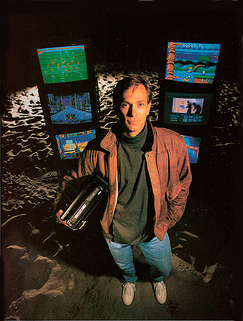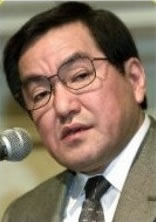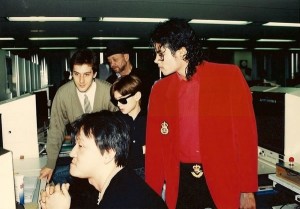 Through the turbulent early ’90s Sega of America underwent a massive transformation that resulted in market dominance. Such rapid growth proved to be too much for the company to sustain, and things soon fell apart as the 16-bit market began to lose ground to more powerful, 32-bit hardware. Employees of the company during this time took part in a roller coaster of a business that rose and crashed almost too fast to comprehend.
Through the turbulent early ’90s Sega of America underwent a massive transformation that resulted in market dominance. Such rapid growth proved to be too much for the company to sustain, and things soon fell apart as the 16-bit market began to lose ground to more powerful, 32-bit hardware. Employees of the company during this time took part in a roller coaster of a business that rose and crashed almost too fast to comprehend.
One person with a front row seat to these events is Scot Bayless, a former Technical Director and producer for SOA. During his tenure with Sega, Bayless saw the change in leadership, the arrival of the many new peripherals and add-ons, and the start of the company’s downhill slide. He was right there for the debut of the Sega CD, and he saw the conception and development of the 32X.
Mr. Bayless was kind enough to take some time to talk with us about his Sega experiences.
Sega-16: Most gamers know you from that famous Sega CD ad, where you’re standing in front of a wall of monitors while holding the machine under your arm. What was going through your head during that shoot? Did you think the marketing was there to make the Sega CD a “must have” machine?
Scot Bayless: I love this question. Actually, what was going through my head was, “Crap I’m cold…” That shoot started at about 11AM on Stinson Beach, just north of San Francisco. The shot they used was taken around nine p.m. The agency brought in a very talented, very high profile fashion photographer to do the shoot and the setup took hours, during which time I went through the most bizarre serial clothing change I’ve ever experienced. They had a couple of people holding up blankets while I stripped stuff off and tried stuff on until the guys directing the shoot were happy. The only articles of clothing in that picture that were actually mine were my shoes and my boxers.
The original plan was to get a shot of me with those monitors backlit by the setting sun. Unfortunately the photographer could never get the lighting the way he wanted it. So we ended up finally getting the shot in the dark, with generators and kleigs providing the illumination. Seems to me we could have just poured sand on a sound stage floor and gotten the same shot, but hey I’m just the talent.
To answer your question about marketing, in complete candor I think the thrust of Marketing’s approach in those days was to pitch Sega as “cool.” That whole campaign was aimed at making us look hipper than Nintendo. In fact, if you read the copy from the original version of that ad, they actually used the line, “those guys work at Nintendo.” that got pulled before the piece went to print but the message was still there. Sega=badass, Nintendo=enginerds. (their POV, not mine).
Sega-16: When you arrived at Sega of America, the company was pretty small, and there were few peripherals and accessories aside from the Arcade Stick and the Power Base Converter. What was it like to see the company morph into the producer of all kinds of hardware revisions, CD and 32-bit add-ons and portable systems? When did it begin to seem like Sega was overextending itself?
 Scot Bayless: It’s funny, but you absolutely nailed the thing that people at Sega were talking about in the break rooms in 1993. When I joined SOA we had about 40 people in Product Development and about the same number in other organizations. So all in, maybe 100 or so people. I remember we did an offsite with the entire team and we fit them all in a fairly small room. Two years later, we were at something like 15x that many people. In the ramp-up toward Saturn, huge new organizations were created. And a lot of these folks weren’t really that experienced in making games. I remember one very senior technology guy saying in a meeting with the producers, “What’s the big deal? It’s just a bunch of sprites moving around the screen!” Yeah, and Mozart just wrote a bunch of notes.
Scot Bayless: It’s funny, but you absolutely nailed the thing that people at Sega were talking about in the break rooms in 1993. When I joined SOA we had about 40 people in Product Development and about the same number in other organizations. So all in, maybe 100 or so people. I remember we did an offsite with the entire team and we fit them all in a fairly small room. Two years later, we were at something like 15x that many people. In the ramp-up toward Saturn, huge new organizations were created. And a lot of these folks weren’t really that experienced in making games. I remember one very senior technology guy saying in a meeting with the producers, “What’s the big deal? It’s just a bunch of sprites moving around the screen!” Yeah, and Mozart just wrote a bunch of notes.
My point is that the massive influx of new people completely swamped the existing culture of focus on the product, replacing it with a focus on presentation. Now don’t get me wrong. Showmanship counts. Sometimes it counts for a ton. But if, at the end of the day, you don’t have something people are actually willing to pay you for, you’re going to find yourself in a very bad place.
Sega-16: You were at Sega under both Michael Katz and Tom Kalinske. Was it hard to make the adjustment to not only a change in leadership but the general direction of the company from one that depended mostly on localizing Japanese games to one that had multiple internal studios making games?
Scot Bayless: You know, it’s funny but I really didn’t notice the transition until kind of after the fact. I arrived at Sega as a TD, working for Jim Huether. I was originally tasked with helping bring Sega CD into the U.S. market and there were massive technical issues to be overcome. Remember, nobody outside the music industry could even burn a Redbook disc here in the U.S. I actually had to go to Tokyo and physically bring back a Toshiba CD writer worth something like $50,000. It made for a really amusing conversation at customs in San Francisco. The agent asked me what the thing was and, after a couple of halting attempts to explain, I just said “it’s stereo equipment.” and wrote down $1000 in value. Oh hell, I’m probably going to jail now…
My point about not really noticing is that I was so incredibly focused on the technical challenges we faced with Sega-CD that I was almost completely unaware of the shift under Tom. I was aware of his arrival, but I had so much on my plate at the time that my reaction boiled down to “Yep. Sounds good. I need to get back to work.” Later, when the internal studio formed and Tom Reuterdahl asked me to come in as his head of technology, I started to realize that SOA wasn’t quite the same outfit I’d joined. Suddenly there were a lot of really talented people swarming around trying to reinvent video games from the ground up. It was a crazy time.
Sega-16: You mentioned that you were involved with bringing the Sega CD to market. Can you tell us how you came to be involved with it? When did you first see the hardware?
Scot Bayless: I joined SOA as a Technical Director right at the end of ’90 and, if memory serves, we started getting preliminary technical information about Sega CD very early in ’91. All the documents were in Japanese, and the guys in Tokyo just didn’t have the infrastructure to translate them, so we started hiring local translators just to get caught up on the docs. The first breadboard dev kits started showing up early in the spring. They were huge, fragile beasts, sensitive to electrical noise and prone to random lockups, but that’s the nature of prototype systems. By summer, we were in full burn, trying to get both our internal titles and several key external projects up to speed. That left us only a few months to launch; it was nuts. We literally worked around the clock all the way up to the launch in New York.
Sega-16: What were some of the technical issues? Former EA programmer Ernest Adams mentioned that developers had to check the status byte to “continually ask it whether the next block of data had arrived,” and he complained of the lack of hardware interrupt line from the CD drive. Were these major issues in game development? Was they a reason for the many cartridge games with CD soundtracks that were released (Wolfchild, Terminator, Sol-Feace)?
Scot Bayless: Ernest is absolutely right. Like him, I had to write polling code to watch that status byte. It was the only way to make sure you weren’t reading dead air. While the Genesis was an elegant design, the Sega-CD/Genesis combination was something of a Frankenstein. Add to that the schedule challenge of trying to get to the launch window with software that could work reliably, and it’s not surprising at all that many developers simply opted to use the unit as a CD player.
Sega-16: Which was the internal studio formed under Tom Reuterdahl? Was it a game studio or purely technical?
Scot Bayless: The SOA internal studio (which was distinct from STI) was organized under Tom to do the Sega CD version of Jurassic Park which Sega licensed non-exclusively from Universal. The entire studio was focused on that product, and the original plan was to make it one of SOA’s tentpole launch titles for Sega CD. So, no, the studio wasn’t purely technical; it was a fully staffed development team, and a big one at that.
The ambition of that team and the Jurassic Park title was huge, and money seemed to be no object. The animators were using Silicon Graphics workstations running Softimage 1.0 and sporting 1gb optical drives that priced at something like $20K per station. People were taking scouting trips to Spielberg’s location shoots in Hawaii, renting steadicams and running them around in the jungle… pretty crazy stuff.
After Jurassic Park, the internal studio never really got traction on their next big thing. There was quite a bit of experimentation, but nothing really took root. And then 32X hit, which siphoned off a bunch of people’s time, followed by Saturn. By then it was pretty clear that SOA was going to have to shrink, and I think they broke up the studio.
 Sega-16: The original design of the 32X was reportedly quite different than what was released. Hideki Sato’s machine was to be a Genesis with more color and little more. What did Sato think of Marty Franz’s design? What was his reaction?
Sega-16: The original design of the 32X was reportedly quite different than what was released. Hideki Sato’s machine was to be a Genesis with more color and little more. What did Sato think of Marty Franz’s design? What was his reaction?
Scot Bayless: As far as I know Sato-san thought very highly of the original design. The problem was cost. 32X was never very clearly defined in terms of its target audience or it’s place in the Sega ecosystem. It was a genuine textbook stopgap. That’s not to say it didn’t have merit. Marty’s original concept for the device was brilliantly simple and powerful. But SOJ very clearly thought of the 32X as a peripheral and, as such, it couldn’t be priced beyond a certain level. That cost cap is what ultimately killed 32X. Sato had to cost reduce it and, by the time the smoke cleared, they had a 32-bleh. I wasn’t privy to the private conversations inside SOJ about how that went but I’d be willing to bet a buck that Sato was just as disappointed as anyone about that.
Sega-16: It’s well known that the impending release of the Saturn was a major factor in cutting short the life span of the 32X, but most people don’t remember that the game industry overall was in a decline at the time. Sega took a hit to its profits to around 64%, Nintendo’s profits dropped around 40% and the market overall dipped 36% according to NPD data. Had this not been the case, do you think the 32X could have lasted longer than it did?
Scot Bayless: Possibly. A rising tide and all that. But, even if you allow for an industry wide decline, 32X was in an incredibly awkward spot vs Saturn. I used to run a weekly producer breakfast on Friday mornings. We’d go to one of several good joints in the Redwood City area and talk about whatever was on our mind. Almost every week one of the hottest topics was, “What the heck are we going to do about 32X?” We all knew that the messaging around the device wasn’t really resonating but we felt powerless to do anything about it.
Sega-16: We never really hear about Hayao Nakayama’s input on the 32X in general, with focus mostly being on his move to make the Saturn successful. Was the 32X’s release purely an American affair, or was he involved?
Scot Bayless: Well he was certainly involved at the incept point. 32X essentially started with a call to Joe Miller at CES. He, Marty Franz and a few of the senior production guys were in Joe’s suite when the call came through. Nakayama-san was on speaker phone and the word was, “We have to counter Jaguar. Make it happen.” The original concept for 32X was literally drawn on a cocktail napkin after that call.
Sega-16: You spent a lot of time working with John Carmack on Doom 32X. Everyone was really expecting a perfect port, but the game is missing levels and the gameplay window is much smaller than other versions. What happened? Was the game another victim of a short development cycle?
Scot Bayless: Yep. That and various technical glitches in the dev hardware. John is a) really freaking smart and b) the Iron Man. I was modestly famous at SOA as the guy who literally didn’t sleep, or even leave the building for five days straight, during the runup to the launch of Sega-CD. But John made me look like a wuss. He worked his butt off to get DOOM into shape, but at the end of it, he had to do some triage to hit his date. The timing was just too tight.
Sega-16: We recently looked over the whole Michael Jackson/Sonic 3 situation, and while there’s lots of evidence pointing to him being involved in some fashion, there’s no evidence of anything official ever coming out of it. Do you know what really happened? Was Jackson really hired to score the game?
Scot Bayless: I met Michael just before that all went down. Possibly the strangest conversation I’ve ever had. By that point, I’d been introduced to a pretty wide spectrum of music guys. David Bowie, Thomas Dolby, Todd Rundgren, Vince Neil and a bunch of others. The music guys were fascinated by the prospect of a game machine that could play ‘real’ music – not those beeps and boops that people thought video games were about.
The PR gang was walking Michael around and he showed up in my office with this trail… this entourage… strung out a hundred feet behind him. We showed him what we were doing with Jurassic Park, and the whole time, maybe 20 minutes, he never made eye contact, barely even responded to anything we did or said. It was like talking to a mannequin. And then he asked about the music for Ecco and I said, “Hey, Spencer Nilsen is right down the hall. Why don’t you come see the music studio?” It was like the guy suddenly woke up from a coma. We took him down to the studio, introduced him to Spencer, and for about the next hour watched as this whole other person emerged. He was animated. He was genuinely engaged, even excited. A completely different person. It was frankly the most amazing thing I’ve ever seen.
I think that was the moment when Michael made the decision to work with Sega. He really wanted to be a part of what he saw happening with Spencer in the studio. As to how things went from there, I honestly don’t have much detail. Roger Hector is the guy who really knows that story.
Sega-16: When you mentioned that Michael Jackson decided to work with Sega after talking with Spencer Nilsen, are you referring to working with the company a second time? The first time was for the Moonwalker game. Was he really planning to do a new project with Sega?
 Scot Bayless: Yeah, actually, it was post Moonwalker, but I don’t think it ever really got anywhere. Sega CD got so many musicians excited but then really never delivered on its imagined potential. Lots of good intentions kind of got left behind after Sega CD.
Scot Bayless: Yeah, actually, it was post Moonwalker, but I don’t think it ever really got anywhere. Sega CD got so many musicians excited but then really never delivered on its imagined potential. Lots of good intentions kind of got left behind after Sega CD.
Sega-16: There has been much speculation as to exactly when Sega of Japan made the call to discontinue the Genesis, though all evidence puts it sometime between 1995 and 1997. Do you know when the decision was actually made?
Scot Bayless: I left Sega in November of 1994, so I wasn’t around for that decision, but clearly the industry was moving in a different direction. The writing was already on the wall as early as 1993. We knew, in our hearts, that the hardware Sega had in the queue wasn’t going to compete very effectively against Nintendo and others. But momentum is a very hard thing to overcome.
Sega-16: Though Microsoft’s Kinect has sold really well, there was initially all kind of speculation about how it might be this generation’s 32X. You commented to that effect to Retro Gamer magazine in 2010. Did it surprise you to see it do so well at retail? Are we finally past the dreaded “add-on equals death” curse?
Scot Bayless: Boy, is that a great question, and I’m definitely eating some crow. What I told the Microsoft guys is that if they failed to integrate the system into their console it would fail. At least in the short term, I was completely wrong. But having said that, I think Kinect is currently on a vector very much like the Wii. A bunch of people bought it, played with it for a season and then stuck it in a closet.
Of course, the good news is that there’s this incredible ecosystem of really smart people emerging around the technology that’s finding fascinating new things to do with it. So, despite my gloomy prognostications, I think the next couple of years will probably produce some genuinely innovative ideas around Kinect.
Many thanks to Mr. Bayless for taking time to chat with us!

Pingback: A história do Sega CD (Mega-CD) - Memória BIT
Pingback: Como a Sega perdeu os EUA - Fazendo Nerdice
And the Sonic/Jackson mystery continues….
I just LOVED the interview, thank you so much for it!
Sega CD was my preferred system from the 16-bit era, my SNES and Genesis were much more fun but the SegaCD was a console that I wanted SO MUCH in that era that when I got it that stuck deeply in my heart until today.
ROAD AVENGER is really touching at my childhood. Thanks for bringing me information that when I was young I could not follow up.
Also, Sega CD was so freaking expensive in Brazil, I couldn´t believe my eyes when I got one (poor dad, I broke him).
Thanks so much for this, Sega-16!
Man, what an AWESOME interview. I just love Sega-16, thanks a lot!
That ad with the monitors is one of the coolest game ads ever. Video game advertising will never be as neat as it was back then.